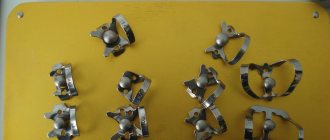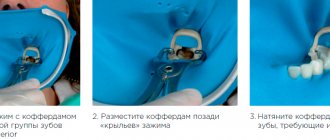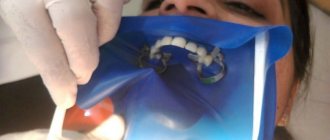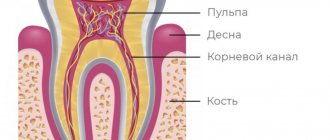Today, the obvious fact is that the level of quality of dental treatment has increased significantly. What affects the quality and long-term treatment is sometimes hidden from the patient’s eyes or he does not attach importance to it. For example, in this article we want to talk about the use of such an auxiliary element in treatment as a rubber dam. It also has other names used: optidam or rubberdam.
Sometimes it may seem to the patient that the dental clinic uses such “add-ons” in order to make the treatment procedure more expensive. Believe me, this is absolutely not true. Below we will tell you why the use of a rubber dam in treatment is indispensable if you want to receive high-quality treatment with long-term results.
Scope of application of rubber dam.
- Endodontic dental treatment . When treating root canals, it is extremely important not only to maintain ideal sterility for the tooth, but also to prevent accidental contact with the oral mucosa of medications that can cause an allergic reaction.
- Restoration of teeth with light-curing fillings and artistic restorations. In order to achieve reliable adhesion of the filling material to the tooth surface, the conditions of absolute dryness of the treated surface must be met, which the rubber dam invariably helps with.
- Teeth whitening. To ensure that the whitening composition, which affects the enamel, does not injure the mucous membrane, the gums must be isolated using a liquid rubber dam. Professional teeth whitening is not complete without the use of a rubber dam.
- Fissure sealing. For high-quality fissure sealing (coating the chewing surface of the tooth with a special composition in order to protect the enamel from destruction by caries), a perfectly dry tooth surface is necessary.
- Splinting of teeth. When splinting, the adhesive material adheres better to the enamel surface when the risk of accidental saliva ingress is eliminated.
What is hidden behind complex names and when to use these tools
Today it is difficult to argue with the fact that in dentistry the level of development of advanced technologies has made it possible to significantly improve the quality of services and bring them to a fundamentally new level. But not all patients clearly understand that dental treatment or restoration largely consists of many little details that are invisible to the average person, each of which is individually important and irreplaceable.
For example, a rubber dam in dentistry. Having heard about it, many believe that this is just another way to extract money from a patient, and do not even suspect that the product can bring significant benefits and contribute to achieving the most positive result. How? Read about this in the material prepared below.
Why rubber dam has positive aspects for the doctor and for the patient.
- Doctor. The specialist can focus on the treatment process, having the most convenient access to the tooth. The working field is visible much better due to achieving optimal cleanliness and dryness through insulation. The treatment process is monitored more efficiently and time is used rationally.
- Patient . Additional protection from accidental injury to the mucous membranes, gums, and lips. Saliva can be safely swallowed; medications used in treatment and elements from dental treatment do not get into it. The muscles and jaw joints experience less stress and are less tired because treatment time is reduced. All this creates greater comfort.
An undeniable advantage is that the installed filling or restoration will last much longer than during treatment without the use of a rubber dam. The main goal is to improve the quality of treatment. The cost to the patient during treatment of using a rubber dam is negligible, and in the long term, it definitely leads to cost savings.
Tatyana Borisovna Sitenkova
Dentist, therapist
33
years of experience
All types of therapeutic treatment, artistic restoration, hygiene procedures of any degree of complexity.
Make an appointment
Cofferdam: long-forgotten old or new in dentistry
A rubber dam or dental rubber dam allows dental treatment to be performed quickly, reliably, and conveniently. But not everyone knows that this device is not a trend of progress at all, but a long-forgotten old one. Thus, the product was first presented to the public more than 100 years ago. It was invented by an American dentist: in those days the system was successful, but was gradually forgotten by doctors. This happened because it did not directly affect the outcome of treatment, plus it increased material costs. Therefore, only a small part of doctors were ultimately inclined to use it, and then it was used only for endodontic treatment.
Today, increased demands are placed on sterility and quality of work performed. Plus, innovations have appeared - restorations using modern materials, whose quality and perfection are steadily growing - which was not the case before. All this requires a high degree of preparation, which is why the rubber dam in dentistry has again gained popularity.
Contraindications and disadvantages.
- If a person has impaired nasal breathing, the use of a rubber dam is contraindicated, since the patient will not be able to breathe normally. Also, the use of rubber dam is not applicable for people with Alzheimer's disease, with epileptic seizures, provided that there is an allergy to talc, rubber or latex. In case of allergic reactions, special sponges and rollers are used to absorb moisture; a saliva ejector also helps to cope with the secretion of saliva. But these measures do not provide such high-quality isolation of the tooth being treated and the service life of the filling is significantly reduced.
- If the doctor is not highly qualified, then when using a rubber dam there is a risk of damage to the interdental papillae.
- To install a rubber dam, it is necessary to work “with 4 hands”, that is, the doctor works in tandem with an assistant.
- Relative disadvantages also include a slight increase in the cost of the treatment procedure. But, taking into account the prospect of a long service life of the filling and high-quality canal filling, the use of a rubber dam makes treatment cheaper.
- The process of installing a rubber dam is often not a very pleasant procedure. But, taking into account further greater comfort during the treatment process: shorter time, less tired facial muscles, no penetration of medications and tissues of the treated tooth into the oral cavity, the discomfort from the installation can be considered minimal.
Yana Dmitrievna Mitskevich
Dentist, therapist
13
years of experience
All types of therapeutic treatment, including endodontic treatment using a microscope, microprosthetics, hygienic procedures of any degree of complexity.
Make an appointment
What is a rubber dam?
So, rubber dam in dentistry - what is it? Take a look at the photo. This is a latex plastic material. The doctor first places it on the patient’s oral cavity before starting treatment, after which he makes the necessary hole to isolate the working area under one, sometimes several teeth. That is, in essence, it allows you to isolate the working field, remove all unnecessary things that may interfere.
The specialist fixes the device using a special frame or clamps, ensures the required level of lip tension and gets to work.
On a note! Have you heard about optidam in dentistry, but have no idea what rubberdam and rubber dam are? It will be useful for you to know that these are the same thing, the only differences are in the names and their translation from English. But the essence of these devices is the same - to ensure sterility and isolation of the working field.
Types of rubber dam.
Classic rubber dam.
This is a latex napkin, which in turn varies in density and thickness. Depending on the purpose, a certain type is used. There are also differences in colors that determine the scope of application. The colors are: light beige, blue, pink, green, gray, blue.
Liquid rubber dam.
Made on a gel basis, when used it tends to be distributed evenly and is fixed when exposed to special light. This type of rubber dam is used for teeth whitening, sometimes in combination with endodontics (canal treatment).
Free consultation
Startsmile experts are leading dentists in Moscow. Doctors at our aesthetic dentistry center SDent are among the leading specialists in the field of dentistry throughout Moscow.
More details
SDent in the TOP 10 best dental clinics in Moscow A place of honor in the ranking of private dental clinics in Moscow in 2022 by the expert magazine about dentistry Startsmile with the support of Kommersant Publishing House
More details
AT THE GERMAN AESTHETIC DENTISTRY CENTER ES-DENT, specialists provide a guarantee for dental treatment and are responsible for the long-term quality result, ensuring the most comfortable condition of the patient during the treatment procedures. That is why the use of a rubber dam has positive aspects for both the patient and the doctor.
Side Effect Prevention
Specialized rubber-based materials cause latex allergies in some patients. Sometimes a negative reaction of the body is provoked by talc, which is sprinkled on the prepared plates.
Manufacturers took into account the comments of doctors and patients and developed a Kentzer Kascher Dental rubber dam without talc. Repeated spraying with liquid removes fine powder.
Another new product is a silicone-based rubber dam. A material with excellent characteristics, but the elasticity is slightly lower than that of a standard coating. A solution was found - dentists use a larger diameter punch.
Write a comment
Zulfiya
April 16, 2022 at 02:59 pm
We came with the child for a consultation, the doctor persuaded her, looked at her teeth, persuaded her for about 10 minutes, but seemed to have found a contact. I was already happy, I thought we would get my teeth fixed by this aunt. This aunt counted us as much as 18,000 rubles. for 4 teeth! I made an approximate calculation, I read it at home, I found this rubber dam there as many as 4 times for 850 rubles! And why such expenses? I called them and asked why we needed this, since our whole life we had been treating our teeth without it. To which I was told that according to some international standards, children’s teeth are supposed to be treated only with this gasket. It’s terrible, now I’m thinking about looking for a new clinic and trying to persuade the child to try a new one.
Renat
April 16, 2022 at 9:21 pm
It's good that they invented this latex napkin. However, the method only recently reached our city. Convenient, just beyond words. You can swallow normally, nothing runs into your mouth. True, your mouth gets extremely dry and you only need to breathe through your nose, since your mouth turns out to be blocked and you can’t breathe through a napkin.
Anton
April 18, 2022 at 02:44 pm
This may be a cool thing, but not all doctors know how to use it. I went to read how they put it on and realized that not everyone can do it. Despite the fact that all my teeth are in place and not destroyed, my dentist tried to pull this scarf on for about 15 minutes, together with the nurse. They calculated something, adjusted things, and in the end they almost gouged out my eye with some piece of iron that flew out of their hands. In short, no thanks, I’d rather sit with cotton balls behind my cheeks. I want to warn everyone, before agreeing, first ask the doctor how many of these scarves she has already worn during her work
Mark Alexandrovich
July 22, 2022 at 12:39 pm
This may be a cool thing, but not all doctors know how to use it. I went to read how they put it on and realized that not everyone can do it. Despite the fact that all my teeth are in place and not destroyed, my dentist tried to pull this scarf on for about 15 minutes, together with the nurse. They calculated something, adjusted things, and in the end they almost gouged out my eye with some piece of iron that flew out of their hands. In short, no thanks, I’d rather sit with cotton balls behind my cheeks. I want to warn everyone, before agreeing, first ask the doctor how many of these scarves she has already worn during her work
Valentina
July 22, 2022 at 21:00
We came with the child for a consultation, the doctor persuaded her, looked at her teeth, persuaded her for about 10 minutes, but seemed to have found a contact. I was already happy, I thought we would get my teeth fixed by this aunt. This aunt counted us as much as 18,000 rubles. for 4 teeth! I made an approximate calculation, I read it at home, I found this rubber dam there as many as 4 times for 850 rubles! And why such expenses? I called them and asked why we needed this, since our whole life we had been treating our teeth without it. To which I was told that according to some international standards, children’s teeth are supposed to be treated only with this gasket. It’s terrible, now I’m thinking about looking for a new clinic and trying to persuade the child to try a new one.
Stas
July 24, 2022 at 10:18 am
It's good that they invented this latex napkin. However, the method only recently reached our city. Convenient, just beyond words. You can swallow normally, nothing runs into your mouth. True, your mouth gets extremely dry and you only need to breathe through your nose, since your mouth turns out to be blocked and you can’t breathe through a napkin.
Liquid material
Rubber dam in the form of methacrylate gel is a good solution for many dental procedures.
First of all, it is easy to apply, effectively isolates the gums, penetrating into the most difficult interdental areas.
The method of applying it is as follows: retractors are placed in the oral cavity to move the cheeks and tongue, a saliva ejector is inserted and the working surface is dried using cotton rolls.
Then the periodontal tissues are covered with a gel, which polymerizes in 20 seconds. The patient is ready for further manipulations. The protective material is removed with careful movements using a special trowel.
Since the liquid version does not protect the entire oral cavity, its main areas of application are:
- professional enamel whitening;
- microabrasion.
Liquid rubber dam is used when additional protection is needed for gums covered with a classic latex curtain.
Terms of use
Installing a rubber dam is an easy task. After developing a certain skill, the dentist, especially with the help of an assistant, can cope with the application of the veil in a matter of minutes.
The rubber dam is fixed using two types of clamps - with and without wings. This affects the sequence in which staples are installed. Options with wings are first placed on the latex, and then attached to the tooth; without wings - vice versa.
The latex napkin itself should be positioned on the face as follows: the smooth side of the surface inside the oral cavity, sprinkled with talcum powder, faces the doctor.
4 methods of applying rubber dam have been developed. An experienced doctor, knows everything and applies the appropriate one for each specific case.
Installation methods:
- The “wings” method is used to work with molars and premolars.
To do this, the main plastic material is attached to the frame, and a clamp with wings is installed in the hole for the tooth, fixed with forceps. An intermediate napkin is applied to the face. Then the installation of the curtain itself begins. The prepared clamp is placed on the tooth, secured under the equator. Finally, the latex is removed from the wings using a special smoothing iron. - The “rubber dam first” option is performed with the participation of an assistant.
To do this, an assistant with both hands carefully guides the latex stretched onto the frame onto the problematic tooth, threads it through and holds it in this position. The doctor uses a specialized thread to pull the material into the interdental spaces and then installs clamps. - The “clamp first” option involves initially installing a bracket without wings on the tooth, and only then stretching the latex over it and onto the frame.
- The “arch” method is designed for manipulating lower molars.
In this case, valves without wings are preferable. Step one: the clamp arc is inserted into the rubber dam and secured with forceps, while the flap itself is folded into a bundle. Step two: the clamp is placed on the tooth. Step three: the flap is straightened and pulled onto the frame.
Removal method:
The process of removing an elastic flap is not particularly difficult, especially when working with one tooth.
You just need to remove the clamp and the latex will come off easily. If there were several working units, the napkin is trimmed with scissors. This takes a little over 1 minute, but it is important to make sure that there are no small pieces of rubber left.
Reviews
Over its long history, cofferdam has earned many positive ratings, both among professional doctors and patients.
Do you have experience with latex curtain? What do you think about her? You can leave your comment here.
If you find an error, please select a piece of text and press Ctrl+Enter.
Tags toothache treatment
Did you like the article? stay tuned
Previous article
Is your child afraid of the dentist? Get him out of trouble!!!
Next article
Correction of a gummy smile using gingivectomy
General overview
A rubber dam is a material that a dentist uses to isolate a diseased tooth during treatment.
Most often this term refers to a piece of latex with a hole. In fact, this is a broader concept, since in addition to standard 15x15 cm flaps, there are also rolled forms of rubber dam, three-dimensional latex plates, as well as its liquid version.
The invention is not new at all. Dental treatment using this technology was first performed in the mid-19th century. Who owned the original idea is a moot point, since both the Frenchman La Roche and the American Sanford Christie Burnim claimed authorship.
One way or another, but since 1867, rubber dam (from the German Kofferdam) or rubber dam (English version Rubberdam) have entered the practice of dentists everywhere.
The traditional rubber dam material is cis-1,4-polyisoprene, obtained from the sap of a tropical plant, Hevea brasiliensis.
Nowadays, International Rules for performing a number of dental procedures require the mandatory use of a rubber dam.
When can you do without a latex pad?
In some situations, dental treatment can be carried out without the help of a rubber dam. Here are some of the cases when the insulation may not be fixed or it simply cannot be done:
- the presence of braces or a bridge in the mouth, under which film cannot be placed,
- anatomical features of the dental system,
- minor restoration and enamel whitening,
- working with the subgingival area, when the latex pad can only complicate the doctor’s manipulations,
- no assistant - installation must be done with four hands.
Modern dentistry offers other options for isolating the work area. For this purpose, ordinary cotton swabs, liquid rubber dam, tips, saliva ejectors and other devices can be used. All of them are characterized by their advantages and disadvantages, but they cannot become a complete replacement for a latex napkin. In any case, the dentist chooses the method of tooth protection based on the existing clinical picture, but taking into account the wishes of the patient.
- Borovsky E.V. Therapeutic dentistry. Textbook for medical schools, 2004.
Alternatives
The main role of the rubber dam is to isolate the tooth from possible moisture. Traditionally, this is solved with the help of cotton rolls that are placed around the tooth. But they have to be changed frequently, they interfere with the dentist’s view and cause discomfort to the patient.
A more modern option is saliva absorbent pads (Dry Tips). They have greater absorbency and fit more comfortably in the mouth. But their insulating characteristics are still inferior to rubber dam.
For timely removal, a saliva ejector is used. But its use requires the constant presence of an assistant. This device takes up a certain place in the mouth and can interfere with the dentist’s work.
The following isolation methods are less often practiced:
- retraction thread;
- fum tape;
- liquid rubber dam;
- Tofflmayr matrix holder with metal matrices;
- sectional matrices and wooden wedges.
Learn about the advantages of the device and one of the application methods from the video.









